There is a lot of information out there about adding a new puppy to your family. There is not as much info about reasons to adopt an adult dog.
This post is about adopting an adult dog and tips for adding that second dog to your home.
Adopting an adult dog brings extra challenges, especially when you already have other pets. It can be easier OR more challenging than adding a puppy, depending on many factors.
IN THIS POST (click below to jump ahead):
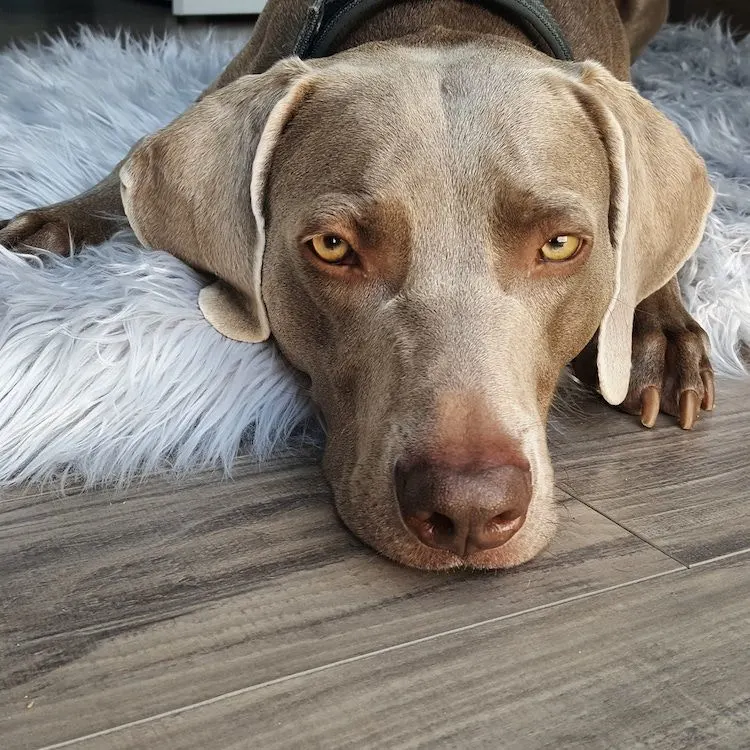
Adopting a second weimaraner
I originally wrote this post because we had planned to adopt a second weimaraner. We tried to adopt Remy’s 2-year-old sister.
However, we decided not to adopt this particular dog because of her intense prey drive around my cat. So yes, there are challenges to adopting an adult dog in addition to the benefits I go over next.
Now, here are my 10 reasons to adopt an adult dog in general vs. getting a puppy. Next, I’ll share several ideas for adding a second dog to your home.
10 reasons to adopt an adult dog
There are also benefits to buying or adopting a puppy, of course. They are somewhat of a “clean slate” there for you to mold (for better or worse).
But there are also some real benefits of getting an adult dog.
*Enjoying this article? Get realistic dog training tips emailed once a week. Click Here
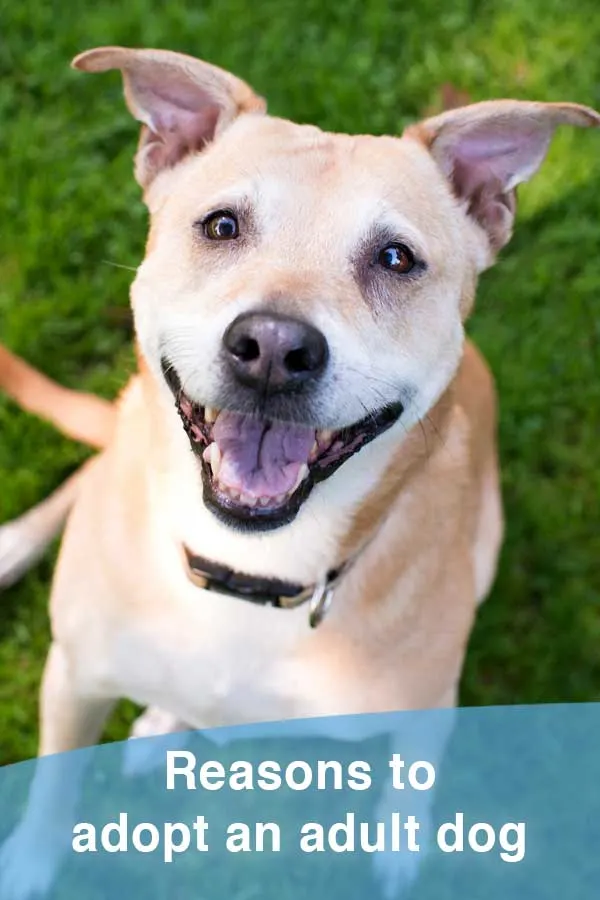
1. You can start exercising an adult dog right away.
For me, this is one of the top reasons to adopt an adult dog! While I do take little puppies for walks right away, I don’t start running with puppies until they are at least 6 months old. And even then it is a slow, short “jaunt” for a few months. I give them time for their joints to develop.
See my post: How far can I walk my puppy?
With a mature adult, you can ease into a running routine right away. Building up gradually, of course, depending on what the dog is used to.
I recommend you try a couple of 2-3 mile runs to see how your new dog does and then slowly build up the miles. Even if the dog is active, she might not be used to running on a leash.
2. Adult dogs are fully vaccinated (usually).
Puppies usually need additional booster shots, and until then you have to be somewhat mindful of where you take them and who they socialize with.
Adult dogs, on the other hand, have likely had their shots or you can have them done right away. You shouldn’t have to worry about your adult dog picking up diseases like parvo or distemper.
See my post: Can you walk a puppy before it has its shots?
3. They have the attention span for training.
Adult dogs can focus for more than 30 seconds! Haha.
4. Size and personality are clear.
You know what you’re getting into. Although, it can take up to a month or so for an adult dog’s true personality to shine in their new home. The first few days, they might be overly excited and stressed or a bit shut down or scared.
If the dog lived in a foster home or with their previous owner before coming to you, they should be able to tell you a lot about the dog’s personality, behavior, energy and “quirks.”
For example, I knew that Raven (the dog we had hoped to adopt) would chew up blankets and she loved the water and playing fetch. I also knew that she had an easygoing personality and had done well with other large dogs, both males and females.
5. Most adult dogs are already potty trained.
Not the case with Raven, as she has lived as an outdoor dog. However, I think it will be easier to potty train her compared to a puppy. Since she is an adult, she can hold it longer and won’t have to go every 30 minutes. And she already has the habit of going potty outside since that’s what she’s used to doing.
See: How to potty train an adult dog
6. Might have had some basic obedience training.
One of the reasons to adopt an adult dog is some dogs have had at least some basic training such as “sit” or “come.”
They may also be crate trained or potty trained and they likely have experience walking on a leash. They’ve likely had some life experiences like riding in a car and going to the vet so not everything is brand new to them.
*Enjoying this article? Get realistic dog training tips emailed once a week. Click Here
7. Adult dogs are past the chewing, biting and teething stage.
Young adult dogs might still want to chew on shoes and furniture, etc. However, they should be past the crazy teething stage as well as the puppy mouthing/biting stage.
You’ll still need to supervise your adult dog and help them learn the rules, but they won’t be quite as crazy as a 12-week-old puppy!
8. The dog might already be spayed or neutered.
This could be a pro or a con, depending on your situation. But for most of us in the United States anyway, it’s a positive thing if the dog is already spayed or neutered.
That way you don’t have to worry about marking (as much), surgery cost, recovery time or females going into heat.
There are also pros if the dog has not been spayed or neutered yet. For example, most research says it’s best to wait to have a dog (male or female) spayed or neutered until they are fully developed.
See my posts:
9. You could save a dog’s life.
One of the best reasons to adopt an adult dog is you might be saving a dog’s life. You’re also opening up a place at the shelter or rescue group for another dog in need.
10. Adult dogs have less energy than puppies!
One of the best reasons to adopt an adult dog and save yourself some sanity!
Cons to adopting an adult dog
While this post is focused on the reasons to adopt an adult dog, I do want to mention a few of the “cons.” In some ways, getting a puppy is easier. Here’s what I mean:
- Bad habits may already be developed. Behaviors such as barking, digging, counter surfing, pulling on the leash.
- Adult dogs may be nervous of things they haven’t been exposed to such as car rides, bikers, new people, children or other dogs
- You don’t get to experience that cute puppy stage! (OK with me! haha!)
- The dog may not have been properly socialized to other dogs, cats, children, men, etc. (In our case, we did not adopt Raven after all due to her serious aggression around cats. No fault of her own, it’s just what it is.)
OK, now I’m going to share some tips on introducing your adult dog to your home if you already have pets.
10 tips for adding a second dog to your home
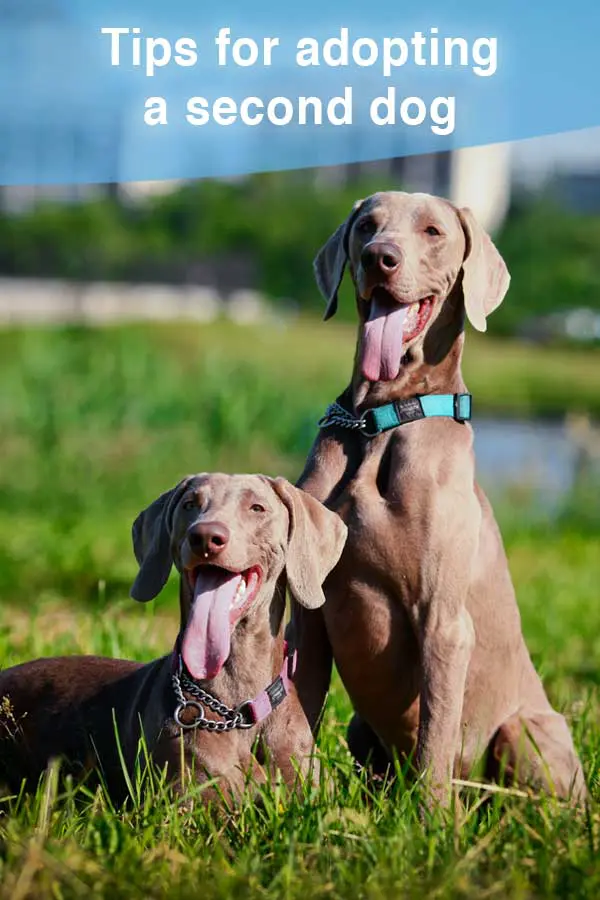
These are the 10 things I do whenever we add a new dog to our house. I’ve fostered a lot of dogs, meaning we temporarily provide a shelter dog a home while he waits to get adopted.
These safety precautions have always helped when we have a new dog around our own dog.
I also followed these tips when I tried to adopt a second dog last winter. Unfortunately she did not do well with our cat, but following these tips helped me learn more about her while keeping all of the pets safe.
1. Adjust our routine before we bring home the new dog.
My current dog Remy and cat Scout are sensitive to change. So I moved the crates where I wanted them ahead of time. I adjusted the feeding and walk routines too. This make the adjustment of having a new dog easier for all of us.
2. Head out for a long, long walk with both dogs.
I’m sure this won’t surprise any of you. I took my dog Remy and potential new dog Raven on a long walk together almost immediately as their introduction to each other. (One of the reasons to adopt an adult dog – you can go for long walks right away!)
A long walk helped Raven get to know her surroundings and get familiar with us. And visa versa.
It’s not a good idea to allow any nose-to-nose sniffing right away. Instead, head out for a “pack walk.”
Ideally, one adult or older child handles one dog and someone else walks the second dog. Start out with some space between the dogs and keep moving forward. If all goes well, allow the dogs to sniff each other after a few minutes.
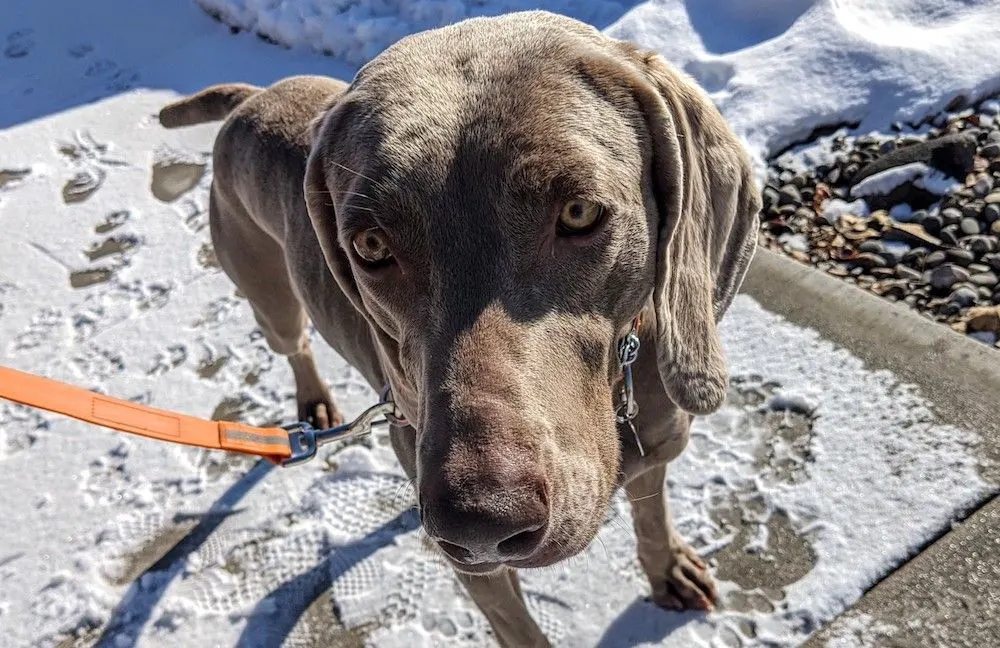
A walk helps a dog decompress from the stress of travel or shelter life and will burn some energy!
Read about how to introduce two dogs here.
3. Continued daily exercise.
I provided structured walks and runs every single day for both dogs. Exercise is my number one “training” tip! I was lucky I was able to handle both dogs together on my own almost right away. That may not be the case for you. Walking the dogs together helps them bond as a “pack” and saves some time. However, it’s not always possible to walk two dogs together.
Here are some more tips for slowly introducing dogs that will live together.
4. Crates and gates – more crates than dogs.
I’m a huge advocate for crate training and since Raven was already used to sleeping in a wire crate, that helped us tremendously. I received two extra crates from Carlson Pet Products so we had a total of three wire crates for two dogs!
I know not everyone has the space or the money for extra crates, but I set up two crates downstairs for at night or when I was not able to supervise.
The third crate was upstairs in our kitchen/living room area where we spend the most time if we’re not working.
That way I had a place to put one dog when I needed to separate them or give them breaks from each other. But the crate allowed them to still be near us.
5. Prevent fights between dogs.
The dogs had separate feeding areas, in their crates.
We did not have many toys out. I believe toys make weimaraners extra nutty and I don’t encourage excited playing in the house. They each received their own items to chew on like Kongs and bully sticks, but they were separated at first to prevent fights.
Dogs can fight over almost anything of value – the water dish, a dog bed, the area around a person, a doorway – so supervise closely.
Expect a few minor fights to happen. But you can prevent most issues.
6. Feed your new dog in her crate or behind a gate.
Some dogs might be too stressed to eat right away in their new environment.
After a walk with Raven on her first day with us, I briefly showed her around the house. Then I introduced her to her spot in her crate.
I gave her some food there and a Kong with peanut butter as well as some simple bedding – a sheet and a towel. Then I let her have some quiet time to decompress for at least 45 minutes.
Remy went in his crate, too. We use fold-up wire crates from our sponsor Carlson Pet Products. I set up the two crates in the same room since both dogs seemed to like that.
I believe calm downtime is important for everyone the first few days to minimize stress and excitement. For the people and for the cat in the house, too!
7. Consistent routine.
I do better with a routine and so does every animal I’ve ever lived with.
We get up around the same time every day, the pets are fed at the same times, we head out for our walks around the same times every day.
The dogs learn to settle in midday when I do my most important work. I provide them with daily exercise, training and things to chew. In return, I expect them to allow me time to work uninterrupted. Crates and Kongs help with this if needed!
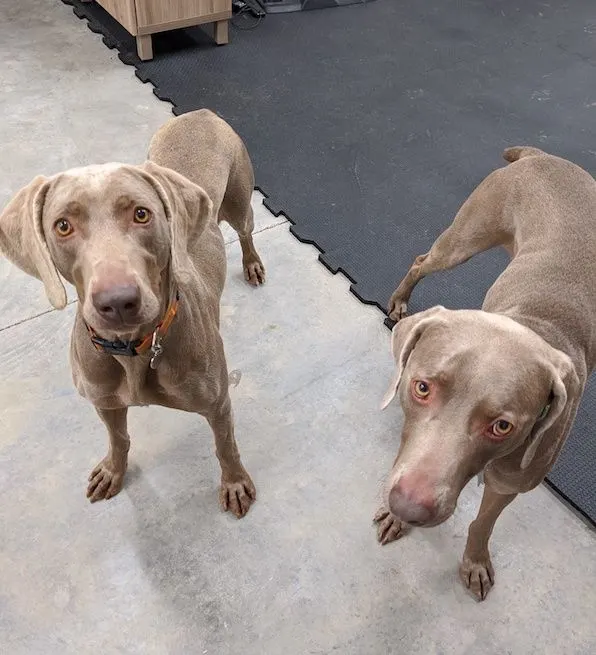
I’m lucky I can work from home or from my office which is only two blocks away. I worked mostly from home when Raven was adjusting to our routine.
Yet, I also wanted to leave for short periods right away so she could get used to that as well. I did have a Nest camera set up so I could check in on how she was doing in her crate when I was not home.
8. Begin basic obedience training.
For some dogs, it is a lot to simply work on reinforcing their name, the new routine and potty training.
Raven had not had much for leash training or obedience and nothing for house rules. So we worked on the basics, which was a lot for her to take in.
I didn’t work on much more than “sit,” “down” and “stay.” Even walking on a leash in a neighborhood was new to her. We took things slowly.
9. Use training collars for safety on walks.
You should have some sort of training collar or harness ready to make walking your new dog as easy as possible.
Perhaps a martingale collar, a no-pull harness would work well for your dog. Gentle Leaders also work for some dogs, but I don’t recommend one for the first walk.
Gentle Leaders fit over the dog’s muzzle, and they’re hard for dogs to get used to. You want your first walk to be fun and stress free.
SAFETY TIP: Be extra careful that your gear fits your new dog properly as the last thing you want is for her to slip out and bolt in her new surroundings.
For example, prong collars can break a part, dogs can slip out of or back out of collars that fit too loose and some dogs can twist out of harnesses.
You may want to have your leash clipped to both a harness and a collar for safety. Place the gear a little tighter than you normally would and make sure your dogs have ID tags and ideally an updated microchip as well.
10. Setting boundaries with our cat.
We have a senior indoor kitty – Scout. Raven is a powerful hunting dog who had been introduced to retrieving birds and tracking down rats. She comes from several generations of competitive working dogs.
We ultimately decided we could not adopt Raven due to her aggression with our cat.
While we were making our decision, we were extremely cautious. Raven and Scout were never unsupervised and Raven was always on a leash or in her crate.
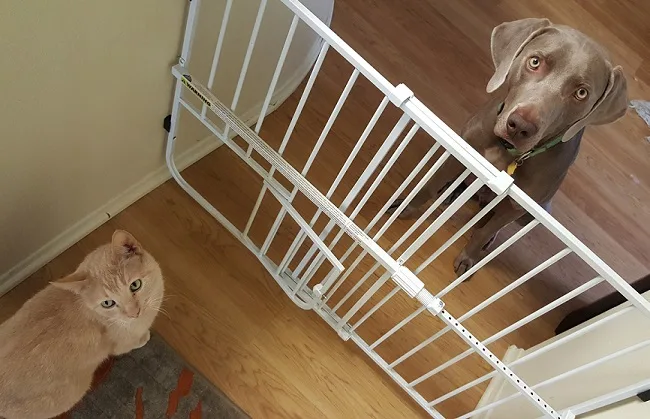
Our current dog Remy is good with our cat, which we thought might help Raven understand that our cat is part of our “group” or “pack.”
However, the dynamics can change when two dogs are together. Two dogs can easily become a pack – mimicking each other as a team in ways they may not act alone.
Thankfully, this did not happen with Remy but it’s something to be aware of when you have groups of dogs together.
See our post: Can weimaraners live with cats?
E-collar training around the cat
We have a Garmin e-collar with a remote, and I had planned to use it with Raven if needed. However, shortly after witnessing her extreme prey drive with our cat I decided it was not worth the effort in trying to train her.
I would only be managing her instincts, at best. An e-collar is certainly an option for the right situation, however.
Other than that, see how things pan out.
Ultimately, with two dogs, life can become quite chaotic if you let it. Believe it or not, I like a calm, structured home and I believe that’s possible even with two young dogs!
I believe in providing sporting breeds with what they need – TONS of exercise, consistent training and boundaries, things to chew and time to play.
In return, I believe it’s fair to ask them to give me time to work while they settle in and do nothing for a few hours midday.
Remy learned this is part of the routine right away as an 8-week-old puppy. My old guy Ace loved to nap while I worked. I think a new dog would learn the routine quickly as well.
I’m sad it did not work out for us to adopt Raven, but she is living a good life. It’s just not with us. We will add a second dog to our family when we are ready.
What advice do you have about adding a second adult dog?
In the comments, I welcome your advice and tips. This is helpful for me and for anyone else about to add a second adult dog.
And if you have any questions about adding a second dog, let me know and I’ll do my best to answer.
*Enjoying this article? Get realistic dog training tips emailed once a week. Click Here
Lindsay Stordahl is the founder of That Mutt. She writes about dog training, dog exercise and feeding a healthy raw diet.

M.A. Kropp
Thursday 16th of January 2020
We've never had two dogs at once, so I can't comment there. But congratulations on adding Raven! I am sure, with a little guidance, training, and time, everyone will settle in very well.
Lindsay Stordahl
Thursday 16th of January 2020
Thank you!
Roxanne
Thursday 9th of January 2020
We just added 10 y.o Clark to our family! This fabulous boy was one day away from being euthanized and heart worm positive. He joins Rosie who was 6 when we adopted her from Puerto Rico where she escaped from a puppy mill, and Buddy who is our “baby” at age 2 when he came into the family. We love older dogs and are not puppy people! #adoptdontshop
Carol (Mattie's Mom)
Thursday 9th of January 2020
Our story is not adding a second dog, but adopting a 6 month old puppy--what a challenge it has been. Like adopting a teenager. Reading that it is usually easier to introduce a puppy to a cat, we thought it would be best for our 4 1/2 year old cat. (Our two previous dogs were each at least a year old when we adopted them and it went well, but thought we might be pressing our luck.) Our Murray had been the sole pet after each dog passed and he likes lots of attention, thus he is not one to hide away. While we train our puppy, Mattie, with treats, Murray wants in on the action. I continue to work on their time together.
Nancy Stordahl
Saturday 4th of January 2020
This is so helpful. When we decide to get another dog some day, I'm pretty sure it'll be an adult dog. We've always gone the puppy route, but I think we're ready to try an adult dog for the reasons you wrote about. The main advantage for me is that you can get a really good idea about personality and temperament. With pups it's such a gamble.
So exciting you're adding another weim! She's one lucky dog! Get ready, Remy! Looking forward to reading all about it. Good luck to you all!
Lindsay Stordahl
Saturday 4th of January 2020
I feel like we just now barely made it past the puppy stage alive. Not ready for that again quite yet!